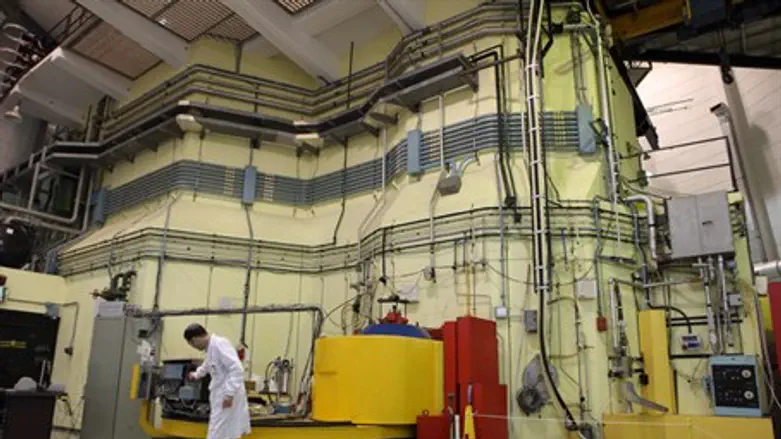
The Pentagon has redesigned its biggest "bunker buster" bomb with more advanced features intended to enable it to destroy Iran's most heavily fortified and defended nuclear site, the Wall Street Journal reported on Friday.
U.S. officials see development of the weapon as critical to convincing Israel that the U.S. has the ability to prevent Iran from getting a nuclear bomb if diplomacy fails, and also that Israel's military can't do that on its own, the report said.
According to the Wall Street Journal, several times in recent weeks, American officials, seeking to demonstrate U.S. capabilities, showed Israeli military and civilian leaders a secret Air Force video of an earlier version of the bomb hitting its target in high-altitude testing, and explained what had been done to improve it, according to diplomats who were present.
In the video, the weapon can be seen penetrating the ground within inches of its target, followed by a large underground detonation, people who have seen the footage told the Wall Street Journal.
The newest version of what is the Pentagon's largest conventional bomb, the 30,000-pound Massive Ordnance Penetrator, or MOP, has adjusted fuses to maximize its burrowing power, upgraded guidance systems to improve its precision and high-tech equipment intended to allow it to evade Iranian air defenses in order to reach and destroy the Fordow nuclear enrichment complex, which is buried under a mountain near the Iranian city of Qom.
The upgraded MOP designed for Fordow hasn't been dropped from a plane yet.
The improvements are meant to address U.S. and Israeli concerns that Fordow couldn't be destroyed from the air. Overcoming that obstacle could also give the West more leverage in diplomatic efforts to convince Iran to curtail its nuclear program.
"Hopefully we never have to use it," said a senior U.S. official familiar with the development of the new version. "But if we had to, it would work."
Iran admitted in the past it was moving more centrifuge machines for enriching uranium to the underground Fordow facility, the existence of which only came to light after it was identified by Western intelligence agencies in September 2009. The UN’s nuclear watchdog, the International Atomic Energy Agency, has confirmed that Iran begun enriching uranium at the plant.
Fordow has long been thought to be a target that would be difficult if not impossible for the U.S. to destroy with conventional weapons. In January 2012, U.S. officials disclosed they didn't think their largest bomb could penetrate to the centrifuges within the complex, where Iran refines fuel it maintains is intended for civilian use but the U.S. and its allies believe is destined for a nuclear-weapons program.
At the time, the Pentagon had spent about $330 million to develop about 20 of the bombs, and sought additional funding to make them more effective, reported the Wall Street Journal. That money came through; so far, the Defense Department has now spent more than $400 million on the bombs, which are built by Boeing Co., BA +1.46% according to government officials.
U.S. intelligence agencies have concluded that Iran's nuclear sites are so well fortified that Israel's military alone can't deliver what a U.S. official called "a knockout blow." Even if Israel were able to obtain its own MOP—and U.S. officials said they haven't offered it to its ally—U.S. officials said Israel doesn't have stealth aircraft capable of carrying the bomb to its target deep inside Iran.
U.S. officials said they believe the enhanced U.S. bunker-busting capability decreases the chances that Israel will launch a unilateral bombing campaign against Iran this year and possibly next year, buying more time for the Obama administration to pursue diplomacy after Iran holds elections in June. Israeli officials declined to comment.
Prime Minister Binyamin Netanyahu said this week that Iran is continuing to progress to the “red line” of nuclear capability which he set during his United Nations speech in September.
He added, however, that there is still time to stop Tehran from crossing that red line.
A top defense official told Channel 10 News this week that despite appearances to the contrary, Israel's military option on Iran was very much alive, and that Iran was reaching the point where construction of a nuclear weapon was within reach.
The official, whose identity was kept under wraps, is considered a highly placed, highly reliable source. The official said that Iran has in recent months “dramatically” increased its uranium enrichment capabilities, the result of the installation of new centrifuges. With the new equipment, Iran should be able to soon enrich as much as 200 kilos of uranium. With that amount, the source said, Iran would be able to easily equip a nuclear arsenal.
(Arutz Sheva’s North American Desk is keeping you updated until the start of Shabbat in New York. The time posted automatically on all Arutz Sheva articles, however, is Israeli time.)
